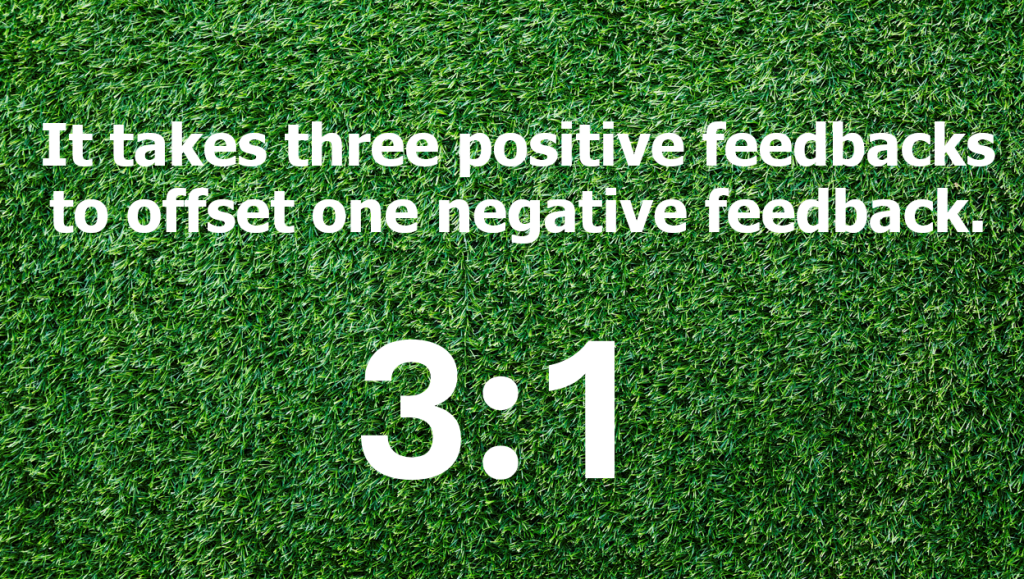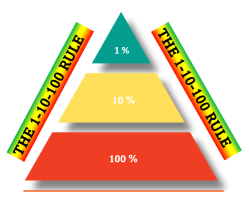The 3-to-1 Positivity Ratio
How many positive feedbacks do you need to receive in order to accept one negative feedback?

In order to be satisfied in our workplace, the ratio of positive to negative feedback cannot be worse than three to one. There is a lot of research on this subject, and there is no difference between them. Three positive feedbacks create the opportunity and condition for a negative feedback to be received and accepted.
According to Dr. Barbara Fredrickson, a positivity researcher at the University of North Carolina, for every deeply distressing negative emotional experience you face, you need to have at least three uplifting positive emotional experiences to balance it out. She refers to this as the 3-to-1 ratio, which fosters a harmonious relationship between your survival mindset and your thriving mindset.
The acceptance or tolerance of negative feedback is not primarily about whether it is true or not, but rather about how capable we are of listening, enduring, and accepting it without constantly defending ourselves, denying it, or even attacking back.
It’s simply about listening and accepting. Accepting that others may see things differently than we do, and that they may perceive us differently than we perceive ourselves.
And it doesn’t work like this: if we receive more and more negativity, we’ll become more and more capable of enduring it. This cannot strenghten us. Positive feedbacks are what strenghten us. Positive feedback is what makes us open to accepting negative feedback. And as the research shows, in a 3:1 ratio.
Positive feedback in a work environment refers to acknowledging and appreciating an employee’s efforts, achievements, or improvements. It’s an essential tool for motivating employees, boosting morale, and fostering a productive and supportive atmosphere. Positive feedback highlights what people are doing well, reinforces good behaviors, and helps to build confidence and job satisfaction.
Why Positive Feedback Matters:
- Boosts Morale and Motivation: It makes employees feel valued and recognized, which can increase their drive to perform well.
- Encourages Growth: Positive feedback helps employees understand what they’re doing right, reinforcing good habits and performance.
- Strengthens Relationships: It helps to build trust and respect between colleagues and supervisors, creating a positive work culture.
- Increases Engagement: When employees feel appreciated, they are more likely to be engaged and committed to their work.
How to Give More Positive Feedback:
- Be Specific: Instead of vague praise like “Good job,” say, what gives clear guidance on what was appreciated.
- Be Timely: Offer feedback as soon as possible after the event or behavior. Immediate positive feedback has a stronger impact and reinforces good actions.
- Focus on Effort and Progress: Acknowledge not just the outcome but the effort, dedication, or growth someone has shown.
- Make It Personal: Tailor your feedback to the individual. Everyone appreciates different kinds of recognition. Some may prefer public praise, while others may prefer private acknowledgment.
- Public Recognition: When appropriate, share positive feedback in a team or company-wide setting. This can encourage others and create a culture of appreciation.
- Encourage Team Efforts: Recognize group successes or collaborations, and highlight how the team worked together to achieve a goal. This builds a sense of community and shared purpose.
- Balance Criticism with Praise: If you need to give constructive feedback, try the “sandwich” method—start with a positive comment, provide constructive criticism, and end with another positive note.
- Be Genuine: Your feedback should always be sincere. People can tell when praise is not authentic, which can diminish its impact. Be specific and honest about why you’re recognizing their efforts.
- Celebrate Milestones: Acknowledge significant achievements or milestones—whether it’s completing a project, reaching a goal, or mastering a new skill.
- Make It a Habit: Incorporate positive feedback into your everyday interactions, not just during formal reviews. The more frequently employees hear positive reinforcement, the more motivated and confident they’ll feel.
Giving positive feedback regularly helps create an environment where employees feel valued and empowered, fostering a more positive and productive workplace.
Let’s not be stingy with recognition, and let’s carefully consider what and how we deliver negative feedback.





